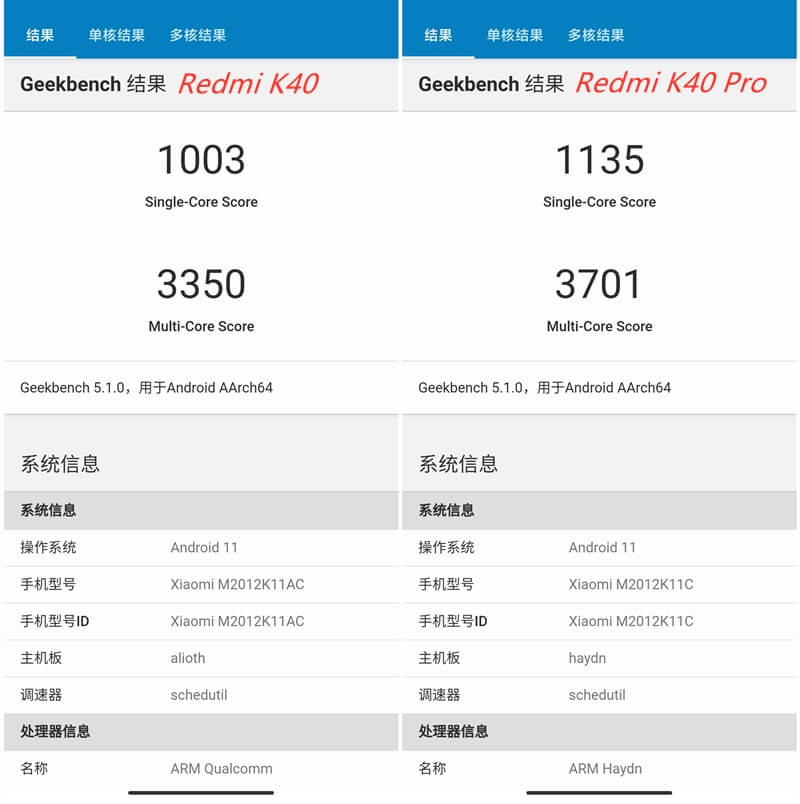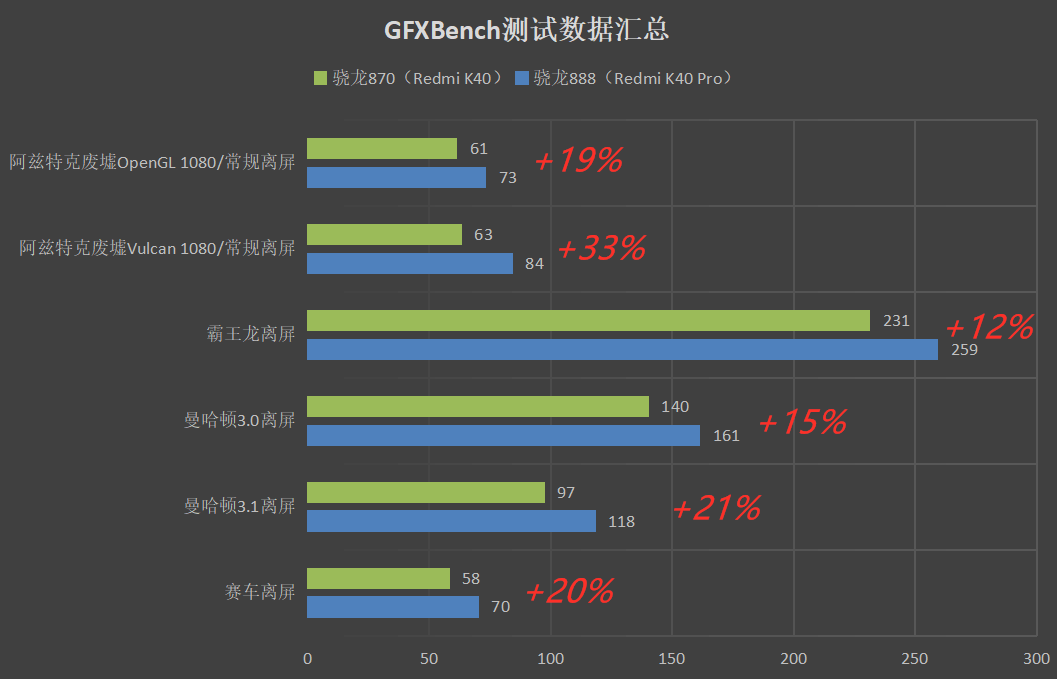three、About Snapdragon 870 and Snapdragon 888:A mix of old and new! Dimensionality reduction and misplaced competition
Redmi K40 is powered by Snapdragon 870,Redmi K40 Pro and Redmi K40 Pro+ are equipped with Snapdragon 888,Behind this combination is actually the new and old collocation of Qualcomm's flagship core。
——Snapdragon 870 accepts the wrong position competition
Remember Snapdragon 7 Series、Snapdragon 6 series and other flagships、The high-end product line encountered dislocation competition from the MediaTek Dimensity family and the Samsung Orion platform around 2020.。under pressure from opponents,Qualcomm chose to overclock the well-received flagship platform Snapdragon 865 and package it into 870 to re-start the battle。
The Snapdragon 870 on the Redmi K40 is the second iterative upgrade of the Snapdragon 865。Its overall specifications are basically the same as the Snapdragon 865 Plus after the first iterative upgrade of the Snapdragon 865.,The main change is the adoption of an enhanced Kryo 585 CPU core,One of the ultra-large cores is clocked at 3.2GHz,Compared with the Snapdragon 865 Plus, it has increased by 100MHz,360MHz higher than Snapdragon 865,It can be regarded as the ultimate overclocking version of Snapdragon 865。
other aspects,Snapdragon 870 is still manufactured in 7nm process,Integrate one large core + three medium cores + four small core CPUs、Adreno 650 GPU、FastConnect 6800 Wireless Subsystem、Spectra 480 ISP、Hexagon 698 DSP,Plug-in Snapdragon X55 5G baseband,Supports 5G Sub-6GHz and mmWave frequency bands for the global market,Maximum download rate 7.5Gbps,Maximum upload rate 3Gbps。
It is worth noting that,Although some views regard Snapdragon 870 as "Snapdragon 865++",this is not accurate。Snapdragon 870 is more like an ultimate optimization upgrade of Snapdragon 865,Instead of strengthening on the basis of Snapdragon 865+。The most typical is that the wireless module of the Snapdragon 870 is not the FastConnect on the Snapdragon 865+ 6900,but FastConnect 6800。The latter is the native solution of Snapdragon 865,The biggest difference between the two is the support for W-Fi 6E or not。
This also makes Redmi K40 from the hardware level,Lost support condition for W-Fi 6E。But Wi-Fi 6E is an enhanced version of Wi-Fi 6,The biggest improvement is the introduction of support for the 6GHz band,59 more consecutive channels,The peak speed in the short distance scene is much faster。certainly,Wi-Fi6E still needs the cooperation of terminals and routers to exert its full strength。
——Snapdragon 888 is the flagship core of the regular iteration
Snapdragon 888 Specifications,Presumably everyone is already very familiar with,It's built on a new Samsung 5nm process,CPU still has eight cores,However, a new architectural layout has been upgraded,Especially the world premiere of ARM's first super large core architecture Cortex-X1。
The main frequency of the X1 core of the Snapdragon 888 is the traditional 2.84GHz,At the same time, there are three performance-level cores of the A78 architecture,The main frequency is 2.40GHz,And four energy-efficient cores of the A55 architecture,The main frequency is 1.80GHz。It also integrates Adreno 660 GPU,Qualcomm claims a 35% increase in graphics rendering performance,Energy efficiency increased by 20%,At the same time, the display technology has been greatly enhanced,Support 144Hz high refresh rate/high frame rate、True 10-bit HDR and more。
There have been some debates surrounding the Samsung 5nm process adopted by the Snapdragon 888.,We've read about it in detail:
There has never been a fixed industry standard for semiconductor process technology,how to design、Naming is entirely up to each family.。Since TSMC 16nm、Samsung's 14nm is completely messed up,The two companies often start various brainstorming operations in order to look better in terms of indicators,For example, when TSMC 16nm was improved, it was called 12nm. ,Appears to be more advanced than Samsung's 14nm。
The process flow of different fabs,It is indeed difficult to make high and low comparisons at the micro level,For example, the Samsung process technology adopted by Snapdragon 888,It is different from the TSMC process technology we are familiar with - this is especially obvious after 10nm。For example, Samsung's 7nm node has chosen certain layers of EUV (extreme ultraviolet light) lithography,The first two generations of TSMC's 7nm process use immersion lithography with a wavelength of 193nm。
Although their names are "7nm process",But the appearance is always different。and,Samsung's subsequent 6nm,And the 5nm chosen by Snapdragon 888 is actually the evolution of the same generation of 7LPP process,TSMC is not,So the technical paths of both、There is a big difference in the iteration method for a long time,At present, it is impossible to judge the advantages of Samsung 5nm and TSMC 5nm from the microscopic level.、Whether there is superiority or inferiority。
in short,Due to the different standards of the process of different wafer manufacturers、different iterative rhythm、Differences in different naming conventions,It is difficult to compare the high and low performance of the process technology of different wafer manufacturers at the micro level。
Four、CPU performance test:Ultimate Overclocking A77 vs. 2.84GHz X1
Let’s talk about Snapdragon 870 first,The CPU part is a 1+3+4 architecture,Frequency is 3.2GHz、2.42Ghz、1.80GHz,Among them, 1+3 large cores are Coterx-A77 architecture,L3 cache is 4MB,4A small core is Cortex-A55 architecture,1.8GHz frequency。
The CPU of the Snapdragon 888 is also an eight-core design of 1+3+4,Upgraded the new architecture layout,Especially the launch of ARM's first super large core architecture Cortex-X1,It is claimed that the theoretical performance is 20% higher than that of A78。The main frequency of the X1 core is the traditional 2.84GHz,With 1MB L2 cache。
At the same time, the Snapdragon 888 also has three performance-level cores of the A78 architecture.,The main frequency is 2.40GHz,Each has 512KB L2 cache,And four energy-efficient cores of the A55 architecture,The main frequency is 1.80GHz,Each has 128KB L2 cache。These cores share 4MB L3 cache、3MB system cache,The total cache capacity of the entire chip reaches 8MB。
so by comparison,in the cpu section,Theoretically, the biggest improvement of the Snapdragon 888 compared to the Snapdragon 870 is the Cortex-X1 super large core, which is said to be stronger than the A78.,The second is that the three A77 cores are fully upgraded to A78,As for the four small cores, the ancestral A55 remains completely unchanged.。


According to the actual test results,The Snapdragon 870 on the Redmi K40 reaches a single core of 1003、Multi-core 3350,The Snapdragon 888 on the Redmi K40 Pro can reach a single-core 1135,Multi-core 3701。
In this evaluation system,Although the Snapdragon 870 tries to narrow the gap with the Snapdragon 888 with its 3.2GHz extreme overclocking,The single-core test score of Snapdragon 888 is still about 13% higher than that of Snapdragon 870,Multi-core test scores increased by about 10%,The gain of the X1 super large core is still quite large。
five、GPU performance test:Adreno650@670MHz vs. Adreno660@840MHz
GPU side,Let’s talk about Snapdragon 870 first,Its Adreno 650 The frequency of the GPU graphics core is exactly the same as that of the Snapdragon 865 Plus,All are improved on the basis of Snapdragon 865 587MHz,That is Adreno 650 GPU@670MHz,Compared with Snapdragon 865, the graphics rendering speed is about 10% faster。
Compared with Adreno650@587MHz of Snapdragon 865 and Adreno650@670MHz of Snapdragon 870,Snapdragon 888 has been upgraded to Adreno660@840MHz in one go,Qualcomm once claimed a 35% increase in graphics rendering performance,Probably mainly due to the 43% overclocking,More parameter details due to lack of public information,we don't know。

In this evaluation system,According to the actual test results of GFXbench,The effect of Adreno660@840MHz is quite remarkable。
The Snapdragon 888 on the Redmi K40 Pro keeps ahead in all test sub-items,Among them, the Aztec ruins Vulcan 1080p/regular off-screen scene with high load is the most aggressive.,The gap can reach 36%。The improvement rate of other test sub-items is at least about 20%。
So it seems that Snapdragon 888 can overclock up to 840MHz with Adreno660,There is indeed a big gain in terms of graphics capabilities,Has a higher limit performance ceiling。At the same time, the Snapdragon 870 on the Redmi K40 is not far behind.,The same as the former in the first echelon of the Android camp。
next page:Redmi K40 series CPU and CPG energy consumption and energy efficiency test